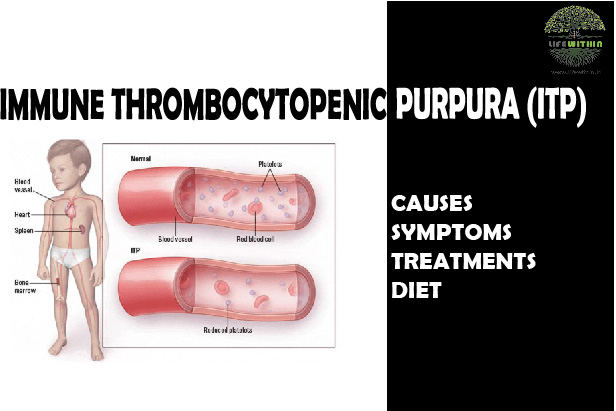How To Deal With Depression During Coronavirus Time? | Dr Prameela Sreemangalam
- Nov 27, 2021
- 938 View
Steam Inhalation Therapy For Common Respiratory Infections | Dr. Vikram Chauhan
- Nov 27, 2021
- 633 View
In ITP, the body is determined to destroy its own platelets, instead of infections by producing antibodies against the p...

ITP: Causes, Symptoms, Treatment & Diet
What is ITP?
Immune thrombocytopenic purpura
(thrombocytopenia meaning decreased number of platelets; purpura referring to
purple discoloring of the skin) is a rare blood disorder that causes low
platelet levels in your blood. Platelets are fragments in the blood that help
in clotting. A decrease in platelets can cause bleeding gums, easy bruising and
internal bleeding. In people with ITP, the body produces antibodies against its
own platelets because it thinks of them as antigens (foreign substances).
It is classified into two following types-
Acute thrombocytopenic purpura is the most
common form of the ITP disorder. It usually affects young children between the ages
of 2 to 7 years old. Acute ITP does not recur and the symptoms usually
disappear within a few weeks.
Chronic thrombocytopenic purpura is
commonly seen in adults, but it can affect teenagers also. Chronic ITP can
recur and the symptoms can last a minimum of 6 months, several years or a
lifetime.
What causes ITP?
In ITP, the body is determined to destroy
its own platelets, instead of infections by producing antibodies against the
platelets. This defect can be a result of any of the following:
Medications: medicines
such as over- the- counter medicines (bought without proper prescription) can
cause allergies in the body that cross- react with the platelets.
Infections: In case of a
viral infection, the viruses present in the body can cause antibodies to cross-
react with platelets.
Immune disorders: People having
disorders such as Rheumatoid arthritis and lupus are said to be at a higher
risk for ITP.
What are the symptoms of ITP?
Since ITP is characterized by reduced
number of platelets leading to excessive bleeding, the symptoms are to related
to increased bleeding. However, each person may experience symptoms differently.
Some common symptoms include:
- Appearance
of bruises at the joints just from the movement
- Tiny
red dots under the skin as a result of tiny bleeds
- Nosebleeds
- Bleeding
gums
- Heavy
menstrual periods
- Blood
in the vomit, urine, or stool
- Bleeding
in head
What to eat and what not to eat?
One cannot cure ITP with a specialized
diet, but eating well can help you manage your symptoms and avoid
complications. Here is a brief list of things you should and shouldn’t eat.
An ideal diet for ITP should include:
- Whole
fruits
- Vegetables
(especially leafy greens)
- Skinless
poultry (chicken breast and ground turkey)
- Fish
(salmon)
- Healthy
fats (olive oil and avocado)
- Nuts
and nut butter
- Whole
grains
- Eggs
While there aren’t any products that are
off- limits for people with ITP, certain food should be avoided in order to
focus on a healthy diet.
Food to avoid may include:
- Ultra-
processed foods like fast food
- Food
and beverages high in added sugars (candies and sodas)
- Processed
meats (bacon and pepperoni)
- Fried
foods (fries and fried chicken)
Please note that if you suffer from any
other diseases or allergies along with ITP, you must consult your doctor before
making any changes in your diet.
How to treat ITP?
Specific treatment for immune
thrombocytopenic purpura will be determined by your health care provider on the
basis of your:
- Age
- Overall
health
- Medical
history
- Extent
of the disease
- Your
choice/ preference
When treatment is necessary, the two most
commonly used treatments are described below:
- Steroids: help prevent bleeding by reducing the rate of
platelet destruction. If effective, the results are seen within a few weeks.
The symptoms may include irritability, stomach infection, weight gain and acne.
- Intravenous gamma globulin
(IVGG): is a protein that
contains many antibodies and also works by reducing platelet destruction. The
result in this case, is seen with a few hours.
Other treatments for may include:
- Rh immune globulin: This medication temporarily stops the spleen from
destroying the platelets. One must be Rh positive and have a spleen for this
medication to be effective.
- Splenectomy: It is a procedure in which the spleen is removed by
surgery, since it is the most active site of platelet destruction
- Platelet transfusion: In case of severe bleeding or people that need to go
into surgery, platelet transfusion may be required.
- Medication changes: If it is a medication that has caused the disease,
discontinuation or changing that medicine is required.
- Lifestyle changes: These can include making sure that you use a
protective gear and that you avoid certain activities.
Chanchal | Life Within

